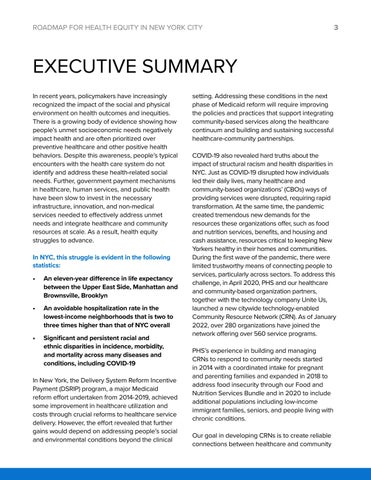ROADMAP FOR HEALTH EQUITY IN NEW YORK CITY
3
EXECUTIVE SUMMARY In recent years, policymakers have increasingly recognized the impact of the social and physical environment on health outcomes and inequities. There is a growing body of evidence showing how people’s unmet socioeconomic needs negatively impact health and are often prioritized over preventive healthcare and other positive health behaviors. Despite this awareness, people’s typical encounters with the health care system do not identify and address these health-related social needs. Further, government payment mechanisms in healthcare, human services, and public health have been slow to invest in the necessary infrastructure, innovation, and non-medical services needed to effectively address unmet needs and integrate healthcare and community resources at scale. As a result, health equity struggles to advance. In NYC, this struggle is evident in the following statistics: •
An eleven-year difference in life expectancy between the Upper East Side, Manhattan and Brownsville, Brooklyn
•
An avoidable hospitalization rate in the lowest-income neighborhoods that is two to three times higher than that of NYC overall
•
Significant and persistent racial and ethnic disparities in incidence, morbidity, and mortality across many diseases and conditions, including COVID-19
In New York, the Delivery System Reform Incentive Payment (DSRIP) program, a major Medicaid reform effort undertaken from 2014-2019, achieved some improvement in healthcare utilization and costs through crucial reforms to healthcare service delivery. However, the effort revealed that further gains would depend on addressing people’s social and environmental conditions beyond the clinical
setting. Addressing these conditions in the next phase of Medicaid reform will require improving the policies and practices that support integrating community-based services along the healthcare continuum and building and sustaining successful healthcare-community partnerships. COVID-19 also revealed hard truths about the impact of structural racism and health disparities in NYC. Just as COVID-19 disrupted how individuals led their daily lives, many healthcare and community-based organizations’ (CBOs) ways of providing services were disrupted, requiring rapid transformation. At the same time, the pandemic created tremendous new demands for the resources these organizations offer, such as food and nutrition services, benefits, and housing and cash assistance, resources critical to keeping New Yorkers healthy in their homes and communities. During the first wave of the pandemic, there were limited trustworthy means of connecting people to services, particularly across sectors. To address this challenge, in April 2020, PHS and our healthcare and community-based organization partners, together with the technology company Unite Us, launched a new citywide technology-enabled Community Resource Network (CRN). As of January 2022, over 280 organizations have joined the network offering over 560 service programs. PHS’s experience in building and managing CRNs to respond to community needs started in 2014 with a coordinated intake for pregnant and parenting families and expanded in 2018 to address food insecurity through our Food and Nutrition Services Bundle and in 2020 to include additional populations including low-income immigrant families, seniors, and people living with chronic conditions. Our goal in developing CRNs is to create reliable connections between healthcare and community


